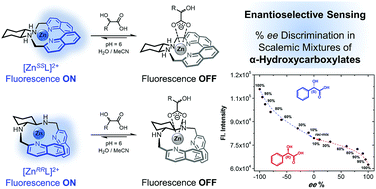Exploiting fluorescent zinc(ii) and copper(ii) complexes for enantiomeric excess determination of hydroxycarboxylates†
Abstract
Chiral hydroxycarboxylates are useful compounds in the syntheses of natural products, pharmaceutical intermediates, and drugs. Here, we report on Zn- and Cu-containing sensors that can distinguish between enantiomers of hydroxycarboxylates through the quenching or the enhancement of fluorescence. A Zn-based sensor—[ZnRRL]2+—is used in an assay to perform analyses of enantiomeric excess (% ee) of scalemic mixtures of α-hydroxycarboxylates and various drugs including the statin drug atorvastatin. This assay enables determination of mixtures of enantiomers across the range from 0 to 100% ee.



 Please wait while we load your content...
Please wait while we load your content...